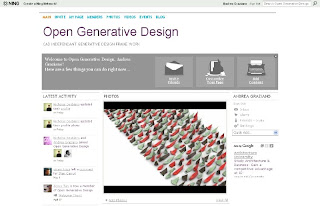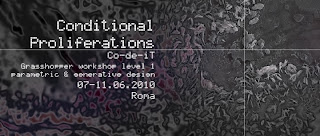
Apomechanes 2010 studio [seminar and workshop] will be held from the 19th of July till the 6th of August. Apomechanes is an intensive 3-week computational design studio held each summer in Athens, Greece.
The studio is devoted to furthering techniques and concepts of algorithmic processes as means for design and fabrication. Apomechanes brings together individuals from diverse backgrounds and fields of study to discuss, exchange and collaborate on projects that investigate modes of algorithmic and machinic processes in architectural design. At present computational techniques are predominantly employed in the optimization, rationalization or surface decoration of more traditionally created wholes. This research instead focuses on the inherent potential of computation to generate space and of algorithmic procedures to engage self-organization in the design process. During the workshop, participants create their own custom algorithms leading to the fabrication of working full-scale prototypes appropriate to their research trajectories. Participants engage closely with computational processes in order to develop an aesthetic and intuition of complexity that resides in a balance between design intent and emergent character.

"INSTRUCTORS:
EZIO BLASETTI, registered architect TEE-TCG, was born in Athens and holds a MsAAD from Columbia University after graduating from the NTUA. Founder of
algorithmicdesign.net Ezio is a partner at
ahylo studio, his recent collaborations include
Acconci Studio, Serge Studio,
biothing and
a|Um studio. He has taught at Columbia University, the Architectural Association, the Pratt Institute.
DAVE PIGRAM is the founding Partner of
supermanoeuvre, Dave Pigram has taught at Columbia University, the Architectural Association, the Pratt Institute, The University of Michigan and The University of Canberra. He has exhibited and lectured on his work internationally and was formerly a project director for Studio Daniel Libeskind.
ROLAND SNOOKS is the founding partner of
kokkugia, Roland Snooks has taught at Columbia University, The University of Pennsylvania, Sci-Arc, University of Southern California, the Pratt Institute, The Royal Melbourne Institute of Technology and California Polytecnic. Roland was the curator of the Australasian section of this year's Beijing Bienalle.
COORDINATORS:
PAVLOS XANTHOPOULOS architect NTUA, MΑrch Architectural Association [AADRL], phd candidate NTUA. Executive coordinator. Partner at
ahylo studio. He was an architect at Zaha Hadid Architects and his work has been published and exhibited internationally.
IOULIETTA ZINDROU architect NTUA, MArchAA Iaac [Institutto de Arquitectura Abancada de Catalunia]. Digital Fabrication Lab coordinator. Partner at
ahylo studio, her collaborations include ΑCTAR architecture and Guallart architects in BCN. Invited jury at UPC, Iaac, Pratt Institute."
Link to the
websiteThe press release can be downloaded
here.
Further material, including a detailed portfolio of the projects from apomechanes 2009 can be found
here.
















